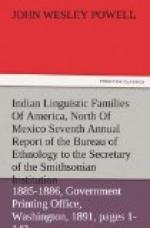The Pawnee group of the Caddoan family in western Nebraska and northwestern Kansas separated the Ponka and Dakota on the north from the Kansa on the south, and the Omaha and other Siouan tribes on the east from Kiowa and other tribes on the west. The Omaha and cognate peoples occupied in Nebraska the lower part of the Platte River, most of the Elkhorn Valley, and the Ponka claimed the region watered by the Niobrara in northern Nebraska.
There seems to be sufficient evidence for assigning to the Crows (Siouan) the northwest corner of Nebraska (i.e., that part north of the Kiowan and Caddoan habitats) and the southwest part of South Dakota (not claimed by Cheyenne[89]), as well as the northern part of Wyoming and the southern part of Montana, where they met the Shoshonean stock.[90]
[Footnote 89: See Cheyenne
treaty, in Indian Treaties, 1873, pp.
124, 5481-5489.]
[Footnote 90: Lewis and Clarke, Trav., Lond., 1807, p. 25. Lewis and Clarke, Expl., 1874, vol. 2, p. 390. A. L. Riggs, MS. letter to Dorsey, 1876 or 1877. Dorsey, Ponka tradition: “The Black Hills belong to the Crows.” That the Dakotas were not there till this century see Corbusier’s Dakota Winter Counts, in 4th Rept. Bur. Eth., p. 130, where it is also said that the Crow were the original owners of the Black Hills.]
The Biloxi habitat in 1699 was on the Pascogoula river,[91] in the southeast corner of the present State of Mississippi. The Biloxi subsequently removed to Louisiana, where a few survivors were found by Mr. Gatschet in 1886.
[Footnote 91: Margry, Decouvertes, vol. 4, p. 195.]
The Tutelo habitat in 1671 was in Brunswick County, southern Virginia, and it probably included Lunenburgh and Mecklenburg Counties.[92] The Earl of Bellomont (1699) says[93] that the Shateras were “supposed to be the Toteros, on Big Sandy River, Virginia,” and Pownall, in his map of North America (1776), gives the Totteroy (i.e., Big Sandy) River. Subsequently to 1671 the Tutelo left Virginia and moved to North Carolina.[94] They returned to Virginia (with the Sapona), joined the Nottaway and Meherrin, whom they and the Tuscarora followed into Pennsylvania in the last century; thence they went to New York, where they joined the Six Nations, with whom they removed to Grand River Reservation, Ontario, Canada, after the Revolutionary war. The last full-blood Tutelo died in 1870. For the important discovery of the Siouan affinity of the Tutelo language we are indebted to Mr. Hale.
[Footnote 92: Batts in
Doc. Col. Hist. N.Y., 1853, vol. 3,
p. 194.
Harrison, MS. letter to Dorsey,
1886.]
[Footnote 93: Doc. Col. Hist. N.Y., 1854, vol. 4. p. 488.]
[Footnote 94: Lawson,
Hist. Carolina, 1714; reprint of 1860,
p. 384.]
The Catawba lived on the river of the same name on the northern boundary of South Carolina. Originally they were a powerful tribe, the leading people of South Carolina, and probably occupied a large part of the Carolinas. The Woccon were widely separated from kinsmen living in North Carolina in the fork of the Cotentnea and Neuse Rivers.




